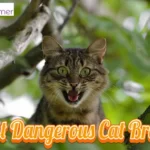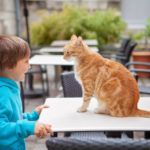If you love cats who are majestic and affectionate, consider the Bengal Cat. It is a mix between the Asian leopard cat and domesticated cat.
A common misconception is that Bengal Cats are wild or aggressive. This is not true!
Bengal cats have been fully domesticated and are brilliant family animals.

Quick facts about the Bengal |
|
|---|---|
| Weight: 8 to 17 pounds | Height: 13 to 15 inches |
| Life span: 10 to 16 years | |
| Intelligence: high | Temperament: social | affectionate | brave |
| Playfulness: high | Activity level: active |
| Vocalness: frequent | Coat length: short |
| Shedding amount: normal | |
| Good with: kids | seniors | dogs | other cats | families | |
| Traits: Bengal cats are also very curious, so they will go exploring around your house. They can get into all sorts of trouble because their curiosity often gets the better of them! | |
The Bengal cat has a beautiful coat that will remind you of a leopard. Bengal’s can have either spotted or marbled coats. They have stripes and or spots that resemble leopards.Their coat colors are a mixture of cream/ivory with yellow, gold, or orange. This makes them look angelic.
Their coat is short and soft.
They are some of the most beautiful cat breeds available.
Bengal’s are very HYPERACTIVE. They are very sociable and love to play. This makes them yet again ideal family animals. They love attention and are very affectionate.
Bengals develop strong bonds with their family and the family’s pets. They are bigger than the average cat and small dog but will play with them nonetheless.
It is important to remember that despite being friendly and affectionate, socialization is crucial. They must be brought into your home at a young age.
Bengal’s are slightly bigger than normal cats. Your average cat would be about 10-12 inches, but the Bengal comes in at 13-16 inches. IT’S A GENTLER MINI LEOPARD!

Bengal cats are very intelligent and eager to please. They can be taught commands such as stay, wait or even fetch. They are often referred to as one of the most intelligent cat breeds.
You might be wondering whether this cat is a good suit for a family. The answer is YES. Bengals are territorial, but are trainable at a young age. They are great family animals.
BENGALS LOVE WATER! Don’t be surprised if your cat jumps into the pool with you. They LOVE drinking water from running sources. If they could choose, they’re likely going for a swim with you.
They do require care and attention. They should be brushed regularly and provided with scratches. They must be stimulated mentally and physically. This can be done with other pets or some fun toys.
Origin
United StatesHealth
Dr. Adedapo Adisa:Deriving their name from their ancestors, the Asian Leopard cats (Felis bengalensis), The Bengal cat breed crosses the Asian Leopard cats with domestic cats from the United States.
With a lifespan circling around 9-15 years, the Bengal cats, although with a gentle and loving personality, are distinguished by the fierce looks of a jungle cat due to their spotted or marble coat coloration.
Although relatively known to be healthy, the Bengal cats are known to have inherited health issues which include; Bengal progressive retinal Atrophy (PRA-b) affecting the Bengal’s eye. Another health issue is the Inherited hypertrophic cardiomyopathy known to affect the heart of the Bengal cats; lastly, a genetic disease known as Erythrocyte pyruvate kinase disease (PK-deficiency).
Bengal Progressive Retinal Atrophy (PRA-b) is an inherited condition that affects the retina in Bengal cats. The retina is part of the eye that houses numerous light receptors and where images and visions are formed. This condition causes the degeneration and destruction of the retina as well as the receptors, which in turn affects the vision of a single or both eyes.
If left unattended, too, this condition can progress to total loss of sight in the Bengal cats. Common symptoms to watch out for in Bengal cats with progressive retinal atrophy are;
● Night blindness in the cat
● Avoiding dark rooms or places
● Nervousness in rooms with inadequate light sources
● Cats bumping into objects while working
● Partial loss of sight.
Because of the cheapness and ease of carrying out the test in identifying this condition, Bengal progressive Retinal Atrophy can easily be identified, and such cats culled from the breeding pool.
Another health condition faced by the Bengal cats is a heart condition known as inherited Hypertrophic cardiomyopathy.
This condition affects the part of the heart that is responsible for pulling out blood. The walls of the left ventricles become hypertrophied or thickened, making it difficult for them to fill up completely with blood.
There is a corresponding increase in the size of the upper part of the left ventricle, known as the left atrium, leading to congestive heart failure and even clot formation in the Bengal cats. If left unattended, it could result in death.
Amongst the symptoms to watch out for in the Bengal cats with inherited hypertrophic cardiomyopathy includes;
● Cats avoiding strenuous activities or exercises
● Shortness of breath in the cats
● Difficulty in breathing
● Paralysis resulting from clots in the blood vessels around the limbs
● Heart murmurs
● Weakness.
Although a common genetic condition in Bengal cats, Hypertrophic cardiomyopathy has no definite test to identify Bengals’ condition.
It is best to visit your Veterinarian or Veterinary cardiologist, who would run multiple diagnostic techniques to catch the condition early enough. Once identified, the cat should be taken of breeding programs completely.
The last of the health issues faced by the Bengal cat breed is Erythrocyte pyruvate kinase disease (PK-def). This is an inherited condition passed from parents to kittens that affect the red blood cells in the Bengal cats.
This condition in the Bengal cats results from a lack of the enzyme pyruvate kinase, which is vital to the production of red blood cells. Because this enzyme is lacking, the cat cannot produce enough red blood cells needed by the body, leading to them having a form of anemia called Hemolytic Anemia.
Common signs to note in Bengal cats having this condition Includes;
● Paleness of the mucous membranes of the eye
● Cat may appear to have jaundice
● Cat may appear tired with increased breathing.
● The abdomen may look swollen.
● Anemia
● Shortness of breath.
If any of these signs have been noticed in the Bengal cats, it is best to take them to a Veterinarian who would carry out a couple of tests to diagnose this condition before they get severe.
Treatment may include supportive therapy and even blood transfusion in cats with severe anemia.
It is important that Bengal cats confirmed to have Erythrocyte pyruvate kinase disease (PK-def) should be discontinued from breeding activities.



Very nice post. I just stumbled upon your blog and wanted to say that I’ve really enjoyed browsing your blog posts. In any case I’ll be subscribing to your feed and I hope you write again soon!
Your article made me suddenly realize that I am writing a thesis on gate.io. After reading your article, I have a different way of thinking, thank you. However, I still have some doubts, can you help me? Thanks.
I don’t think the title of your article matches the content lol. Just kidding, mainly because I had some doubts after reading the article. https://accounts.binance.com/ro/register?ref=JHQQKNKN
I may need your help. I’ve been doing research on gate io recently, and I’ve tried a lot of different things. Later, I read your article, and I think your way of writing has given me some innovative ideas, thank you very much.
Thank you for your shening. I am worried that I lack creative ideas. It is your enticle that makes me full of hope. Thank you. But, I have a question, can you help me? https://accounts.binance.com/en/register-person?ref=P9L9FQKY
Very nice post. I just stumbled upon your blog and wanted to say that I’ve really enjoyed browsing your blog posts. In any case I’ll be subscribing to your feed and I hope you write again soon!
https://interpharm.pro/# canadian pharmacy no scripts
order prescription from canada – interpharm.pro п»їExceptional service every time!
I am currently writing a paper that is very related to your content. I read your article and I have some questions. I would like to ask you. Can you answer me? I’ll keep an eye out for your reply. 20bet
You have a talent for simplifying complex notions; I really understand it now.
Your point of view caught my eye and was very interesting. Thanks. I have a question for you. https://www.binance.com/pt-BR/register?ref=YY80CKRN
En la actualidad, el software de control remoto se utiliza principalmente en el ámbito ofimático, con funciones básicas como transferencia remota de archivos y modificación de documentos.
I don’t think the title of your article matches the content lol. Just kidding, mainly because I had some doubts after reading the article. https://www.binance.com/tr/join?ref=PORL8W0Z